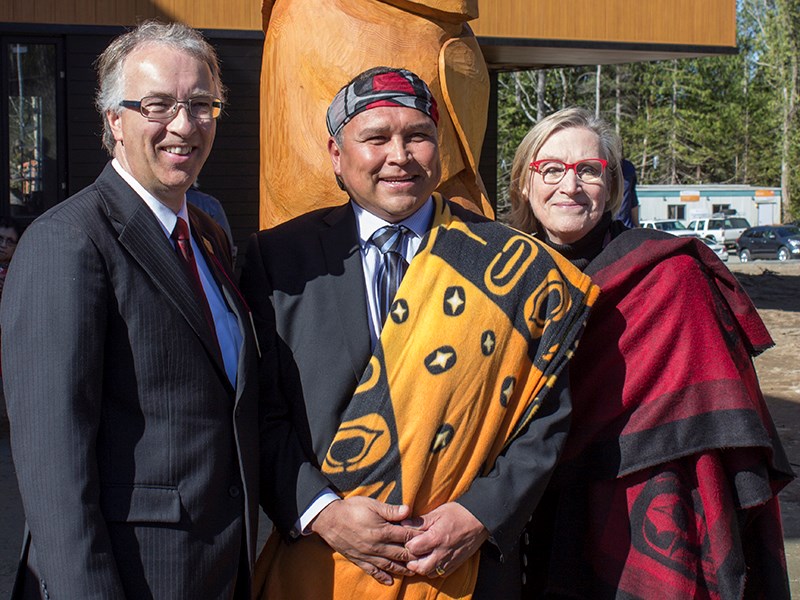A large crowd of supporters gathered at Tla’amin Nation’s new Government House on Klahanie Drive Saturday, April 9, to witness the unveiling of three totem poles and three welcome poles.
While work is still yet to complete on Tla’amin’s legislative building, the poles were revealed as part of celebrations for the nation’s new self-governance.
“It’s amazing to see these pieces completed,” said Tla’amin Nation hegus Clint Williams. The carvers were under a tight deadline to complete the project, he said.
“One of the main reasons we had this vision was to make a statement as we enter into self-government,” said Williams. “The Indian Act did not define us or make us Tla’amin people, the Indian Act just made us indians.”
Williams said the carvings on the poles serve as a symbolic reminder of strengthening Tla’amin identity through the rediscovering and spreading of his people’s language and culture.
“This is the symbol we will take on those challenges and improve the lives of all Tla’amin people,” he said.
The totems were carved from red cedar logs, gifts from Klahoose First Nation, harvested from Toba Inlet, about 100 kilometres northwest of Powell River.
The poles were revealed from under white canvas coverings to the crowd’s applause at the ceremony. Six carvers worked to complete the poles in time for the opening: locals Randy Timothy, Phil Russell, Alvin Wilson, Vince Timothy, Ivan Rosypskye and Squamish’s Darren Joseph. The carvers and their totems were brushed with cedar boughs as a blessing by Tla’amin elders and youth.
Hundreds of Tla’amin citizens and Powell River residents were joined to celebrate the occasion by first nations leaders from around Canada and representatives of local, provincial and federal governments.
“This is a big step for the Tla’amin people in terms of building their future, for this generation and generations to come,” said John Rustad, BC minister of aboriginal relations and reconciliation. “The province is extremely proud to be a partner with the Tla’amin as we move forward building a future with them.”
Federal minister of indigenous and northern affairs Carolyn Bennett said Tla’amin’s self-government is a hope for many first nations around the country.
“It is truly momentous and such an example for Canada,” said Bennett. “This aspiration for self-government is really what everyone is hoping to achieve from coast to coast.”
Bennett added that she was pleased to be able to attend the ceremony.
“This really is a very exciting day,” she said. “It warms your heart to see the excitement as people get in charge of their own lives. It’s spectacular.”
Sechelt’s Shishalh Nation chief Calvin Craigan was one of many first nations’ leaders to congratulate Tla’amin on its treaty and its new beginnings.
“I’m very happy and it’s so encouraging to see the young ones bringing back the culture,” said Craigan. “It’s been long overdue.”
Craigan added that his nation is on the cusp of completing its treaty through the BC Treaty process.
Chief Austin Bear from Muskoday First Nation came from Saskatchewan for the ceremony. He said he was fortunate to participate and help Tla’amin work through establishing its land code over the past decade.
“I hope this is everything you hope and want it to be,” said Bear.
Tl’azt’en Nation grand chief Edward John also attended the ceremonies.
The totem unveiling was one of two ceremonies that day. A community celebration in Evergreen Theatre at Powell River Recreation Complex hosted by Tla’amin actor, writer and physician Evan Tlesla Adams featured speeches, song and dance, gift exchanges and presentations that ran through the afternoon. Ministers Rustad and Bennett were also in attendance for the second ceremony.
“This is an incredible tribute to our ancestors, elders and entire community,” said Williams.
The theatre was at capacity to celebrate Tla’amin’s self-governance; a reception followed in the upper complex lobby.
Tla’amin’s treaty came into effect one minute after midnight on Tuesday, April 5. The agreement with provincial and federal governments provides Tla’amin ownership over land and resources, lawmaking authority related to its land, culture and public services and rights relating to fishing, hunting and gathering throughout its traditional territory.



